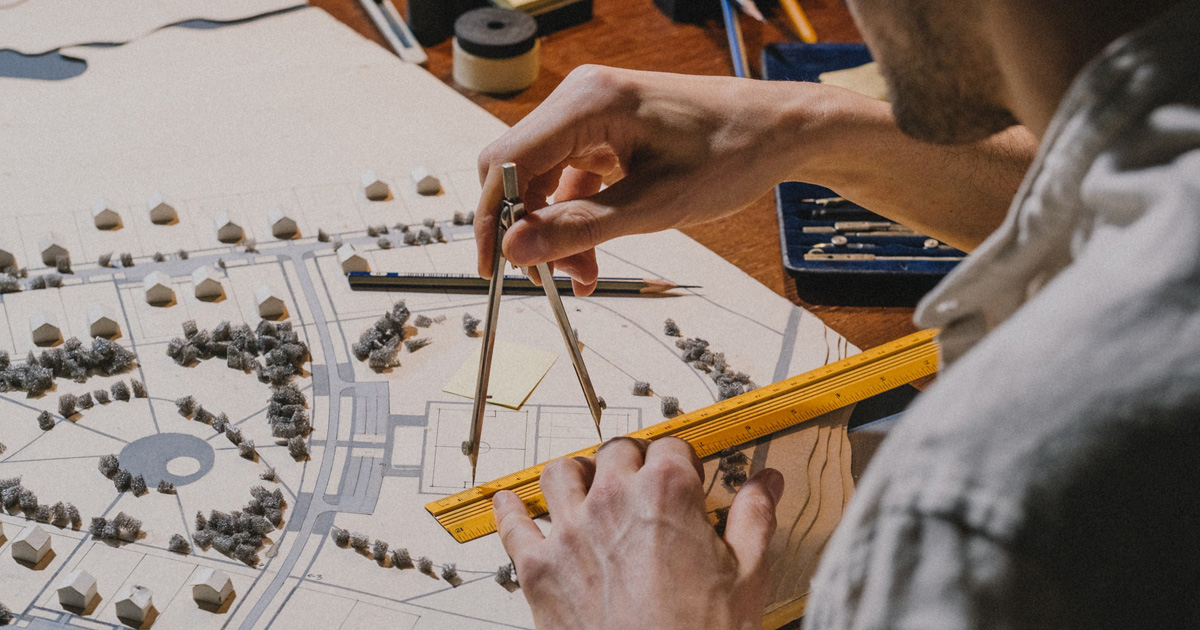Architect Insights on Combining Form and Function
Architect Insights on Combining Form and Function
Blog Article
Understanding the Diverse Career Paths Available for Aspiring Architect
As an aspiring Architect, you have a world of career courses awaiting you. Each path offers special challenges and chances to apply your imagination and technical expertise. Whether you're drawn to traditional style or the nuances of lasting design, there's a niche that straightens with your passions. Understanding these varied options can shape your specialist trip, however which instructions will you choose to discover initially?
Standard Architecture: Designing Structures and buildings
Typical style concentrates on making buildings and structures that blend performance with visual allure. As you explore this field, you'll appreciate the complex balance between type and function. You'll discover to draw inspiration from historic designs, incorporating aspects like balance, materials, and craftsmanship. Your designs can mirror social heritage, showcasing local practices while meeting modern-day requirements.
You'll develop abilities in drafting, model-making, and site evaluation, allowing you to picture and connect your concepts effectively. Involving with clients, you'll need to recognize their vision and translate it into feasible layouts.
Additionally, developing codes and sustainability methods are essential in your work, guaranteeing your frameworks are safe and eco-friendly. As you grow in your career, you'll locate opportunities in household, commercial, or also restoration tasks, each offering unique difficulties. Accepting typical architecture leads the method for a meeting job that admires the past while forming the future.
Urban Preparation: Forming Neighborhoods and Public Spaces
As an aspiring Architect, you can play an important role as a metropolitan organizer, changing just how areas communicate and operate. By utilizing community interaction techniques, you'll assure that locals have a voice in forming their environment. And also, incorporating sustainable style concepts will certainly assist produce spaces that not only fulfill today's demands however also secure the future.
Role of Urban Planners
While numerous might believe of architects as the sole enthusiasts behind structures, urban organizers play a vital role in forming the broader landscape of communities and public spaces. By collaborating with numerous stakeholders, you'll assist make parks, transportation systems, and household areas that advertise social interaction and accessibility. Your competence in spatial layout and neighborhood dynamics permits you to visualize future growth while protecting social heritage.
Neighborhood Engagement Methods
Effective neighborhood interaction approaches are important for city organizers to guarantee that the voices of locals are listened to and valued in the preparation process. To promote purposeful dialogue, you ought to focus on open online forums and workshops where community participants can reveal their concepts and concerns. Use studies and social media sites to reach a more comprehensive audience, guaranteeing varied point of views are consisted of. Collaborating with regional companies can enhance trust fund and facilitate much deeper links. It's vital to offer clear information about proposed jobs and decision-making processes, allowing homeowners to feel informed and empowered. By actively incorporating and listening comments, you'll create spaces that reflect the community's needs, ultimately causing more sustainable and effective urban environments. Embrace openness and constant dialogue for lasting influence.
Lasting Layout Concepts
When designing city spaces, including sustainable style principles is vital for developing atmospheres that thrive both ecologically and socially. Take into consideration incorporating green rooms, like parks and yards, to enhance biodiversity and improve air top quality.
Creating with water preservation in mind is also key-- consider rain gardens and absorptive surfaces to manage stormwater. Including neighborhood members throughout the preparation process guarantees that the areas you develop satisfy their needs and urge social interaction. By accepting these principles, you'll add to dynamic, lasting urban landscapes that benefit every person.

Landscape Design: Creating Lasting Outside Atmospheres
As you explore landscape style, you'll discover crucial design principles that produce functional and attractive outdoor spaces. Lasting methods play an essential role in guaranteeing these environments thrive while decreasing ecological impact. And also, you'll locate a range of profession opportunities that allow you to make a genuine distinction in exactly how individuals communicate with nature.
Design Principles in Landscape
Recognizing design concepts in landscape architecture is crucial for creating lasting outdoor environments that integrate with nature. You'll require to ponder elements like scale, balance, and proportion to ensure your designs feel cohesive and welcoming. Additionally, pay attention to seasonal changes, developing with materials that match the surroundings year-round.
Sustainable Practices Review
Lasting practices in landscape architecture not just concentrate on aesthetics yet additionally focus on ecological health and wellness and resource conservation. By incorporating native plants, you boost biodiversity and reduce the demand for chemical plant foods and chemicals. Implementing reliable watering systems assists preserve water and reduces drainage, protecting close-by ecological communities. You can make areas that advertise dirt health, such as using organic materials and practicing permaculture concepts. In addition, incorporating eco-friendly framework, like rain gardens and porous sidewalks, help in stormwater management and reduces urban warm. You add to a much healthier earth and offer areas that promote area connection when you develop outdoor environments with sustainability in mind. Ultimately, these techniques ensure your styles benefit both people and the atmosphere for several years to find.
Profession Opportunities Exploration
With a strong structure in lasting practices, landscape style uses a selection of job courses that allow you to make a meaningful influence on the atmosphere. Urban coordinators commonly collaborate with landscape engineers to produce environment-friendly areas in metropolitan settings, boosting city livability. If you're passionate concerning education, take into consideration coming to be a landscape design educator, motivating future generations.
Sustainable Style: Concentrating on Eco-Friendly Practices
As you discover your profession in style, accepting environmentally friendly techniques can set you apart in a competitive area. Lasting design concentrates on developing structures that lessen ecological impact while improving occupant wellness. By including sustainable products, energy-efficient systems, and sustainable building strategies, you'll add to a greener future.
Start by acquiring expertise of green accreditations like LEED or BREEAM, which can reinforce your qualifications. Consider exactly how all-natural light, ventilation, and thermal efficiency can enhance style. Team up with engineers and ecological specialists to innovate solutions that decrease waste and save sources.
Don't fail to remember the value of neighborhood participation-- appealing neighborhood stakeholders can motivate layouts that harmonize with the environment. As customers progressively prioritize sustainability, your experience in environmentally friendly methods will certainly not just bring in tasks however additionally fulfill your passion for responsible architecture. Embrace this vital facet of the career, and see your job prosper.
Historical Preservation: Securing and Bring Back Cultural Heritage
While you commence on your architectural trip, think about the necessary function of historic preservation in keeping our social heritage. This field focuses on the security and remediation of considerable buildings, websites, and frameworks that tell the stories of our past. By taking part in historical conservation, you'll aid guard the building legacy that shapes area identification.
As a historic preservation Architect, you'll analyze historic value and examine the condition of frameworks. You'll work very closely with historians and conservationists to ensure genuine remediation strategies are utilized. This profession course enables you to mix creativity with study, enabling you to design remedies that respect initial products and craftsmanship.
Your job not only adds to sustainability by reusing existing structures yet likewise cultivates a sense of satisfaction within neighborhoods. Welcoming this path will assist you become a guardian of history, maintaining the tales and aesthetics that enhance our lives.
Interior Style: Enhancing Indoor Spaces
Historic preservation and indoor style both share a dedication to improving the developed setting, but they concentrate on various elements. try this site While historic preservation highlights maintaining a structure's historical and cultural value, interior design absolutely nos in on optimizing indoor areas for capability and looks.
As an ambitious Architect, you'll find that interior architecture allows you to blend imagination with technological abilities. You'll make rooms that not just look excellent however likewise advertise convenience and efficiency. This field involves comprehending exactly how light, color, and materials engage within an area, influencing state of mind and functionality.
You'll deal with different projects, from property homes to commercial offices, guaranteeing that each environment meets the needs of its residents. By prioritizing user experience, you can change insides right into practical and inspiring spaces, making a significant impact on just how individuals connect with their environments. Accept the opportunity to enhance interior atmospheres and shape the way individuals live and function.
Industrial Layout: Combining Functionality With Visual Appeals
Commercial style plays a crucial duty in producing products that seamlessly mix looks with performance, ensuring that what you make use of everyday is not only aesthetically attractive yet likewise useful. As an aspiring Architect, you could involve yourself in this area, concentrating on making every little thing from furniture to read customer electronics. Your job includes understanding individual needs, products, and manufacturing procedures, allowing you to develop innovative options that enhance day-to-day experiences.
In industrial style, you'll frequently team up with suppliers, engineers, and marketing professionals, making certain that your designs are not only attractive but likewise practical. You'll find out to balance type and feature, focusing on usability without sacrificing style. By refining your abilities in sketching, 3D modeling, and prototyping, you'll be well-appointed to bring your concepts to life. This occupation course provides a vibrant setting where imagination meets functionality, making it a rewarding choice for designers thinking about forming the items of tomorrow.
Often Asked Questions
What Educational Qualifications Do I Required to End Up Being an Architect?
To become a designer, you'll need a professional level in architecture, generally a Bachelor's or Master's. Additionally, you'll have to complete a teaching fellowship and pass the Architect Enrollment Assessment to practice legitimately.
Exist Accreditation Requirements for Various Architectural Job Paths?
Yes, there're accreditation needs for different building paths. Architect. You'll require to pass examinations, full internships, and often pursue specialized training, relying on your chosen emphasis, like landscape architecture, metropolitan style, or historic conservation
What Software Abilities Are Essential for Designers Today?

How Can I Gain Practical Experience While Examining Architecture?
You can obtain useful experience by interning at building firms, joining style competitors, volunteering for area projects, or teaming up with classmates on real-world jobs. These opportunities enhance your abilities and build beneficial connections in the market.
What Work Opportunities Exist Outside Typical Architecture Firms?
You can check out various task opportunities outside standard style firms, like city planning, interior layout, landscape architecture, building monitoring, genuine Read Full Article estate development, or perhaps roles in sustainability consulting. Each offers one-of-a-kind challenges and incentives.
Whether you're attracted to standard architecture or the nuances of sustainable layout, there's a particular niche that aligns with your interests.When creating city spaces, incorporating sustainable style concepts is crucial for producing atmospheres that grow both environmentally and socially.As you explore landscape architecture, you'll find necessary layout concepts that develop practical and stunning outside areas.Recognizing layout concepts in landscape style is essential for creating lasting exterior settings that integrate with nature.In commercial style, you'll commonly team up with designers, marketers, and manufacturers, making certain that your layouts are not only gorgeous but additionally practical.
Report this page